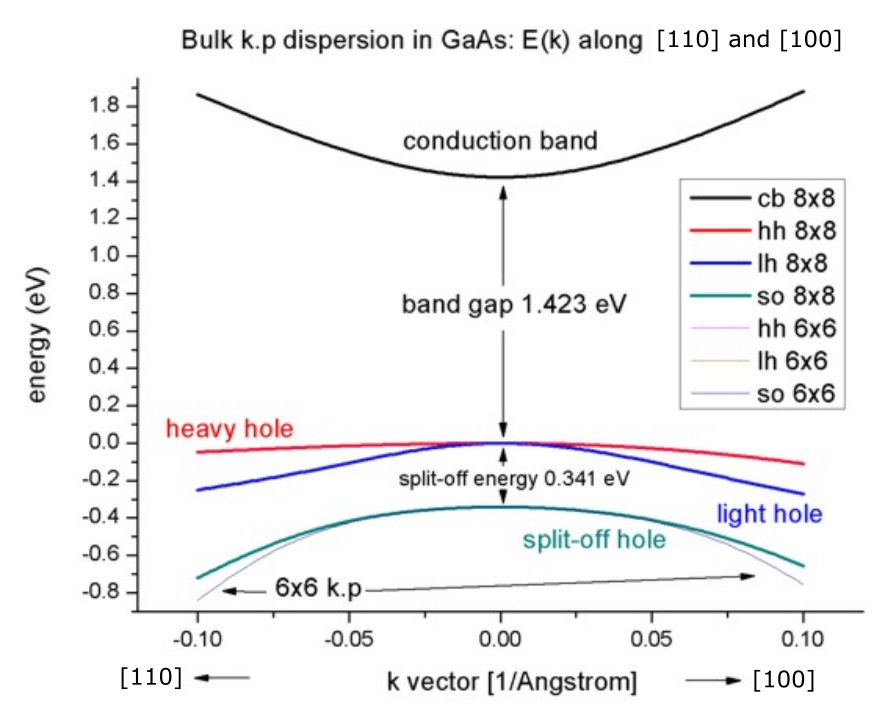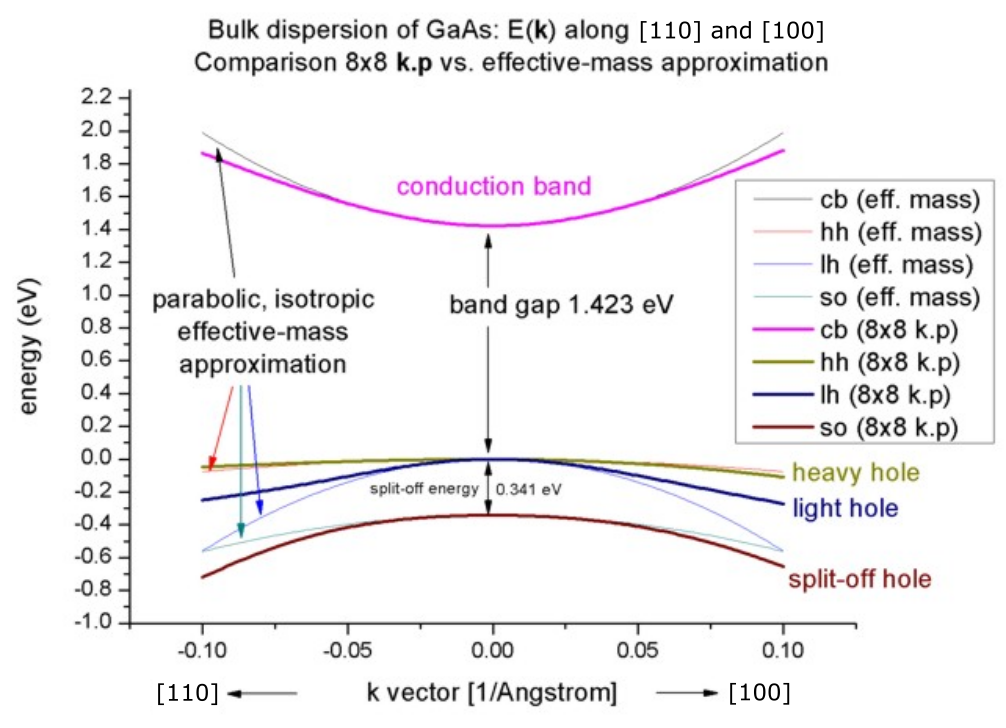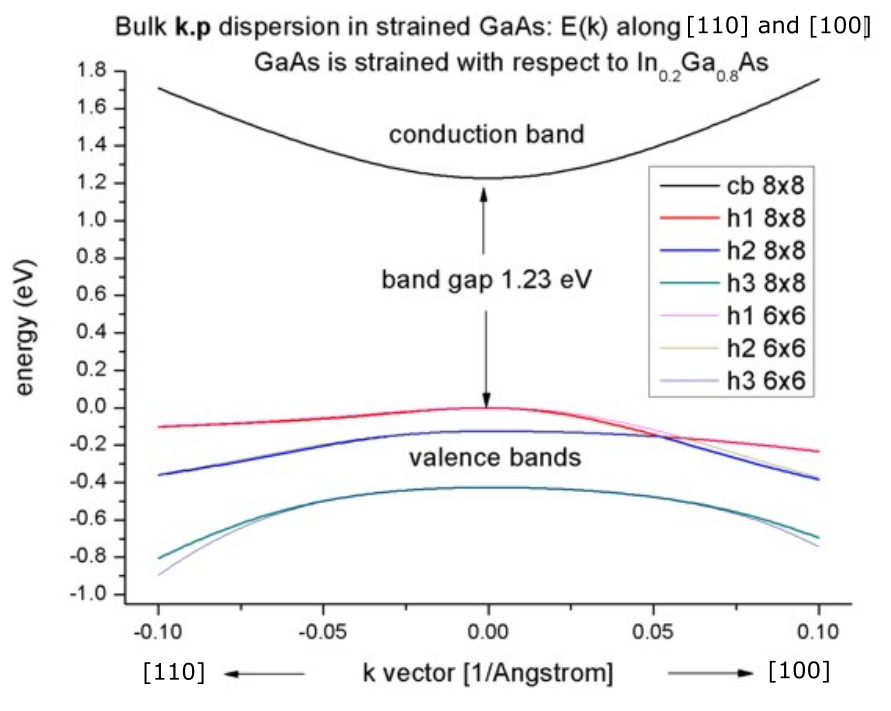k.p dispersion in bulk GaAs (strained / unstrained)
- Input files:
bulk_kp_dispersion_GaAs_nnp.in
bulk_kp_dispersion_GaAs_nnp_strained.in
- Scope:
We calculate
of strained and unstrained .
Band structure of bulk
Input file: bulk_kp_dispersion_GaAs_nnp.in
We want to calculate the dispersion
[000] to [110]
[000] to [100]
We compare 6-band and 8-band k.p theory results. We calculate
Bulk dispersion along [100] and along [110]
quantum{
region{
...
bulk_dispersion{
lines{ # set of dispersion lines along crystal directions of high symmetry
name = "lines"
position{ x = 5.0 }
k_max = 1.0
spacing = 0.01
shift_holes_to_zero = yes
}
path{ # dispersion along arbitrary path in k-space
name = "user_defined_path"
position{ x = 5.0 }
point{ k = [0.7071, 0.7071, 0.0] }
point{ k = [0.0, 0.0, 0.0] }
point{ k = [1.0, 0.0, 0.0] }
spacing = 0.01
shift_holes_to_zero = yes
}
}
}
}
We calculate the pure bulk dispersion at position x = 5 nm. In our case this is position{ x = 5.0 } must be located inside a quantum region.
shift_holes_to_zero = yes forces the top of the valence band to be located at 0 eV.
How often the bulk k.p Hamiltonian should be solved can be specified via spacing. To increase the resolution, just increase this number.
We use two direction in k space, i.e. from [000] to [110] and from [000] to [100]. In the latter case the maximum value of
Note that for values of
The results of the calculation can be found in the folder bias_00000\Quantum\Bulk_dispersions. Figure 2.4.229 visualizes the results.

Figure 2.4.229 Bulk k.p dispersion in
The split-off energy of 0.341 eV is identical to the split-off energy as defined in the database:
...
valence_bands{ delta_SO = 0.341 } # [eV] Vurgaftman1
...
If one zooms into the holes and compares 6-band vs. 8-band k.p, one can see that 6-band and 8-band coincide for

Figure 2.4.230 Bulk k.p dispersion in GaAs:
8-band k.p vs. effective-mass approximation
Now we want to compare the 8-band k.p dispersion with the effective-mass approximation. The effective mass approximation is a simple parabolic dispersion which is isotropic (i.e. no dependence on the k vector direction). For low values of k (

Figure 2.4.231 Bulk k.p dispersion in
Band structure of strained
Input file: bulk_kp_dispersion_GaAs_nnp_strained.in
Now we perform these calculations again for
strain{
pseudomorphic_strain{ }
}
run{
strain{ }
}
As substrate material we take pseudomorphic_strain{ }) with respect to this substrate, i.e.

Figure 2.4.232 Bulk k.p dispersion in
If one zooms into the holes and compares 6-band vs. 8-band k.p, one can see that the agreement between heavy and light holes is not as good as in the unstrained case where 6-band and 8-band k.p lead to almost identical dispersions, compare Figure 2.4.233.

Figure 2.4.233 Bulk valence band k.p dispersion in
Note that in the strained case, the effective-mass approximation is very poor.
Analysis of eigenvectors
(preliminary)
Using the Voon-Willatzen-Bastard-Foreman k.p basis one obtains the following output for the eigenvectors at the Gamma point,
Example: The x_up component contains a complex number. Here, we show the square of X_up. This gives us information on the strength of the coupling of the mixed states.
eigenvalue S+ S- HH LH LH LH SO SO
1 0 1.0 0 0 0 0 0 0
2 1.0 0 0 0 0 0 0 0
3 0 0 0 1.0 0 0 0 0
4 0 0 0 0 1.0 0 0 0
5 0 0 0 0 0 1.0 0 0
6 0 0 1.0 0 0 0 0 0
7 0 0 0 0 0 0 0 1.0
8 0 0 0 0 0 0 1.0 0
eigenvalue S+ S- X+ Y+ Z+ X- Y- Z-
1 1.0 0 0 0 0 0 0 0
2 0 1.0 0 0 0 0 0 0
3 0 0 0 0 0.5 0.5 0 0
4 0 0 0 0 0.166 0.166 0.666 0
5 0 0 0.5 0 0 0 0 0.5
6 0 0 0.166 0.666 0 0 0 0.166
7 0 0 0 0 0.333 0.333 0.333 0
8 0 0 0.333 0.333 0 0 0 0.333
+: spin up, -: spin down
The electron eigenstates are 2-fold degenerate, i.e. have the same energy, and are decoupled from the holes.
1
2
The hole eigenstates are 4-fold (heavy and light holes) and 2-fold degenerate (split-off holes).
3
4
5
6
7
8
Last update: nnnn/nn/nn